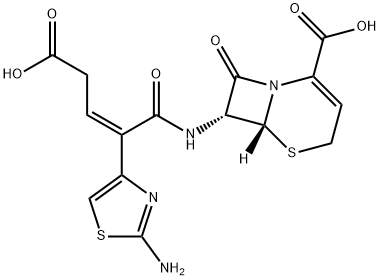Ceftibuten is a new, once daily, orally active cephalosporin introduced as a treatment of
Gram-negative bacteria-related urinarylrespiratory tract and gynecological infections.
In vitro studies of 359 strains of Gram-negative bacteria demonstrated that ceftibuten
was superior to cefaclor and as active or slightly more active than cefixime and
cefteram.
anorexic, antidepressant, inhibitor of 5HT, norepinephrine & dopamine uptake
ChEBI: A third-generation cephalosporin antibiotic with a [(2Z)-2-(2-amino-1,3-thiazol-4-yl)-4-carboxybut-2-enoyl]amino substituent at the 7 position of the cephem skeleton. An orally-administered agent, ceftibuten is used as the dihydrate to tre
t urinary-tract and respiratory-tract infections.
The 1st method of synthesis
The 8-oxo-7-phenylacetylamino-5-thia-1-aza-bicyclo[4.2.0]oct-1-ene-2-
carboxylic acid benzhydryl ester is reacted with phosphorus
pentachloride/pyridine reagent in methylene dichloride, and the reaction
mixture is thereafter cooled to -35°C and treated with methanol to produce
hydrochloride of 7-amino-8-oxo-5-thia-1-azabicyclo[4.2.0]oct-2-ene-2-
carboxylic acid benzhydryl ester. This hydrochloride is reacted with 4-(3-
aminothiophen-2-yl)-5-oxohex-3-enoic acid 3-methylbut-2-enyl ester. Then 7-
[2-(2-benzoylamino-thiazol-5-yl)(3-tert-butyl-4,4-dimethylpent-2-
enoxycarbonyl)-pent-2-enoylamino]-8-oxo-5-thia-1-azabicyclo[4.2.0]oct-2-
ene-2-carboxylic acid synthesized is reacted with aluminum chloride in anisole
and diluted hydrochloric acid and then with dimethylmalonate to give 5-thia-
1-azabicyclo(4.2.0)oct-2-ene-2-carboxylic acid, 7-(((2Z)-2-(2-amino-4-
thiazolyl)-4-carboxy-1-oxo-2-butenyl)amino)-8-oxo-, (6R,7R)- (Ceftibuten).
The 2st method of synthesis
Formulation of the diphenylmethyl thiazoleacetate with ethyl formate leads to
2-(2-aminothiazol-5-yl)-3-hydroxyacrylic acid benzhydryl ester. Condensation
of 2-(2-aminothiazol-5-yl)-3-hydroxyacrylic acid benzhydryl ester with the
phosphorane from benzyl 2-triphenylphosphonium acetate leads to the 2-(2-
aminothiazol-5-ylmethylene)succinic acid 1-benzhydryl ester 4-benzyl ester.
Exposure of this ester to trifluoroacetic acid selectively cleaves the
diphenylmethyl group over the benzyl ester to give 2-(2-aminothiazol-5-
ylmethylene)succinic acid 4-benzyl ester. Condensation of the acid with free
amino group in the desmethyl cephalosporin affords the amide of 7-[3-(2-
aminothiazol-5-yl)-2-benzoylcarbonylmethylacryloylamino)-8-oxo-5-thia-1-
azabicyclo[4.2.1]oct-2-ene-2-carboxylic acid benzyl ester. The remaining
benzyl ester protecting groups are removed by means of aluminum chloride to
afford 7-[3-(2-aminothiazol-5-yl)-2-benzoylcarbonylmethylacryloylamino)-8-
oxo-5-thia-1-azabicyclo[4.2.1]oct-2-ene-2-carboxylic acid or ceftibuten
A semisynthetic cephalosporin formulated as the dihydrate
for oral administration.
It exhibits good activity against many Gram-negative bacilli,
but its activity against Gram-positive cocci is very poor. It
is stable to hydrolysis by the common plasmid-mediated
β-lactamases, but not derepressed chromosomal enzymes .
It is rapidly and almost completely absorbed by mouth and
is excreted in the urine with a half-life of 1.5–3 h. An oral dose
of 400 mg achieves a peak plasma concentration of around
15 mg/L. Binding to plasma proteins is 65–77%.
Side effects mostly consist of mild gastrointestinal symptoms
and mild liver function test changes. Clinical trials have
mainly been conducted in urinary tract and respiratory tract
infections which, despite the poor in-vitro activity against
Str. pneumoniae, have shown ceftibuten to be as efficacious as
comparator agents.
Chemical structure: ?-lactam
Ceftibuten is a third generation cephalosporin antibiotic
Ceftibuten is highly (75–90%) absorbed on oral administration,
but this is decreased significantly by food. Being lipophilic and acidic, it is significantly (65%) serum protein
bound. Some isomerization of the geometry of the olefinic linkage appears to take place in vivo before
excretion.
Ceftibuten (Cedax) is a recently introduced, chemicallynovel analog of the oximino cephalosporins in which anolefinic methylene group (C=CHCH2-) with Z stereochemistryhas replaced the syn oximino (CBNO-) group.
This isosteric replacement yields a compound that retainsresistance to hydrolysis catalyzed by many β-lactamases,has enhanced chemical stability, and is orally active. Oralabsorption is rapid and nearly complete. It has the highestoral bioavailability of the third-generation cephalosporins.Ceftibuten is excreted largely unchanged in the urine andhas a half-life of about 2.5 hours. Plasma protein binding ofthis cephalosporin is estimated to be 63%.
Ceftibuten possesses excellent potency against mostmembers of the Enterobacteriaceae family, H. influenzae,Neisseria spp., and M. catarrhalis. It is not active against S.aureus or P. aeruginosa and exhibits modest antistreptococcal activity. Ceftibuten is recommended in the managementof community-acquired respiratory tract, urinary tract, andgynecological infections.



